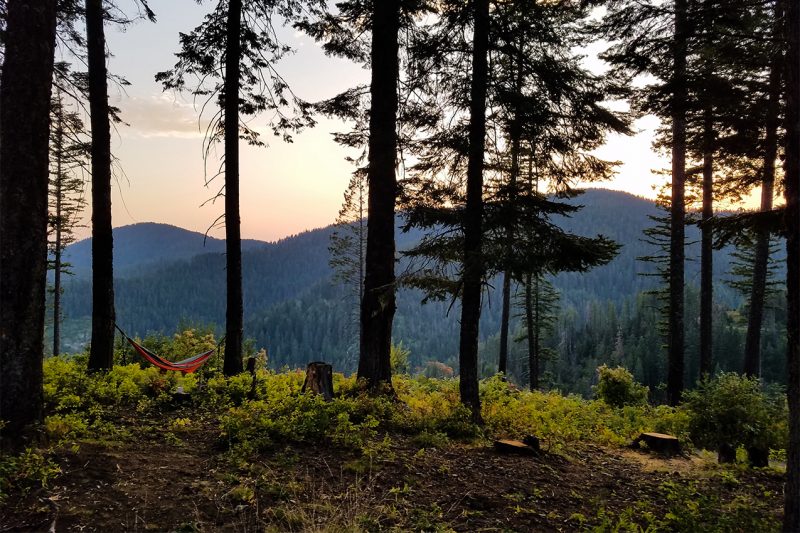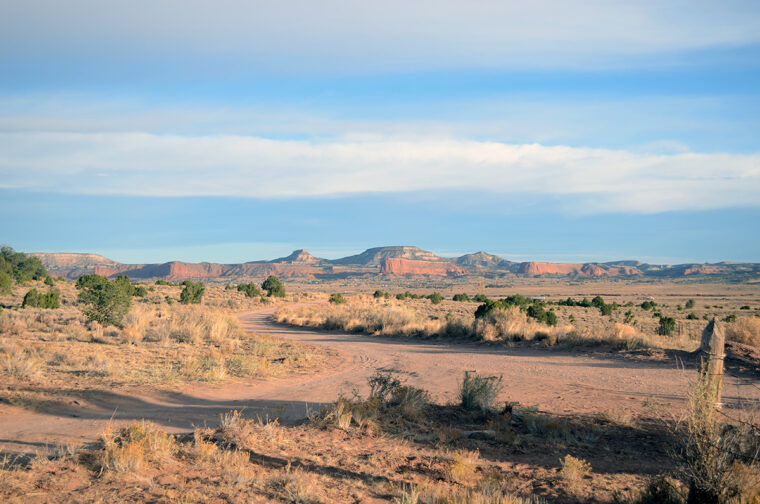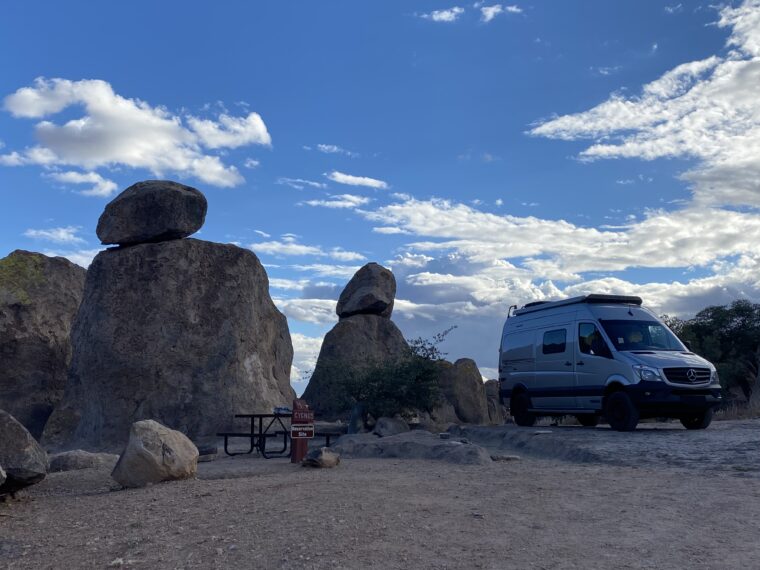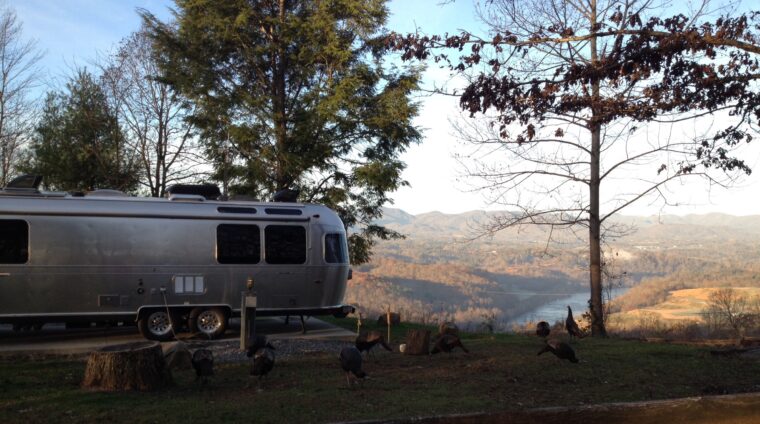Many road travelers center their itineraries around national parks, but why not national forests? National forests are similar to national parks, but they’re often free to visit, dog-friendly, less crowded, more secluded, and full of wild places to explore. Here are the most visited national forests in the U.S. that are certainly worth the trek.
The Ultimate Guide to RV Camping on U.S. Forest Service Land

Coeur D’Alene National Forest, Idaho
Coeur d’Alene National Forest is one of the three national forests in Idaho’s northern panhandle. Pacific Northwest vibes abound here, with heavily treed landscapes, deep lakes, and rugged hills.
Where to Camp
Water activities are a way of life in this national forest, making Bumblebee Campground a perfect docking point for fishing and floating. For $21 per night, you can access 25 sites that allow tent camping or RVs up to 27 feet.
Like other national forests, Coeur D’Alene also offers dispersed camping. If you’re in the mood to boondock, try to find a spot on Old River Road.
What to Do
- Canfield Mountain Trail System: This 25-plus mile trail system is designed with motorized trail bikes and bicycles in mind.
- Lake Coeur d’Alene Scenic Byway: Experience the heart of Coeur d’Alene National Forest while keeping an eye out for moose and bears.
Black Hills National Forest, South Dakota
The Black Hills National Forest of South Dakota has a unique landscape of piercing granite spires, deep canyons, and dense forests.
How to Take an RV Road Trip Through the Black Hills of South Dakota
Where to Camp
Horsethief Lake Campground bustles with activities. It’s not only close to Mount Rushmore, but it’s also a hub for kayaking and hiking. The campground itself has 36 sites that cost $26 per night.
If the excitement of Horsethief Lake isn’t your thing, then follow the road less traveled to Long Draw Road. “Dispersed camping in the Hills is the perfect way to refresh body and soul at the end of the week… This private spot near Lead was an excellent choice for wildlife viewing,” says Campendium reviewer TWilbur. It’s also suitable for RVs under 30 feet.
What to Do
- Hippie Hole: Just a short jaunt from Battle Creek, jump into the refreshing water, and sunbathe on the cool slabs of rock.
- Rock Climbing: The Black Hills is known for climbing. Spearfish Canyon offers several limestone crags.
Ocala National Forest, Florida
There’s a vast expanse of nature north of Orlando where turquoise waters are framed by low-hanging sand pine scrub in Ocala National Forest.
Where to Camp
Juniper Springs is the most popular campground in the national forest. It has 79 sites with access for RVs up to 35 feet, but no hookups (for hookups, stay at Salt Springs Campground). It offers hot showers, concessions, and reservations for $22 per night. Although Juniper Springs offers high-caliber amenities, this campground’s draw is in the beauty of the clear turquoise hues of the spring.
What to Do
- The Springs: Swim, snorkel, or even scuba dive in the many natural springs sprinkled throughout the national forest.
- Kayak: Paddle 7 miles through the sub-tropical forest.
Pisgah National Forest, North Carolina
Pisgah National Forest is an adventure mecca of the East Coast, located around the popular outdoor city of Asheville, North Carolina.
Where to Camp
There’s no shortage of camping spots in Pisgah National Forest. If you’re staying in an RV that doesn’t need a hookup, consider Black Mountain Campground. If you’re tent camping, then check out Rocky Bluff Campground. Roadside camping and primitive camping are also popular with forest visitors in areas like Big Ivy and Linville Gorge.
What to Do
- Rock Climbing: The most popular climbing crags are Tablerock, Linville Gorge Wilderness, and Little Lost Cove Cliffs.
- Horseback Riding: Stay overnight at Harmon Den Horsecamp and experience a new way to see the national forest.

Bighorn National Forest, Wyoming
Did you know northern Wyoming’s Bighorn National Forest is one of the oldest government-protected forest lands in the country?
7 Campers Share What They Wish They Knew Before Boondocking
Where to Camp
Bighorn National Forest has numerous campsites, but Campendium camper Nomadic Nutritionist recommends Sitting Bull Campground: “This is the second year we stayed at Sitting Bull Campground… There are multiple hiking trails from camp as well as ATV trails… It’s a large campground with many spots for big rigs (ours is 36 ft), and the camp hosts keep the pit toilets very clean.” There are 42 sites for both RVs and tents at nearly $18 per night during peak season.
What to Do
- Fishing: “The Bighorn River is a world-class trout fishery, unrivaled even in Montana,” according to the National Park Service.
- ATV: There are several trails throughout the forest designated for ATVs, including Penrose Park Trail and Dunwood Trail.
Medicine Bow National Forest, Colorado & Wyoming
Medicine Bow National Forest blends Colorado and Wyoming together across various mountain ranges, including Elkhead, Gore Range, Flat Tops, Sierre Madre, and Medicine Bow Mountains.
Where to Camp
When you head to Medicine Bow, be sure to try and camp at Vedauwoo Campground, a unique campsite practically built into the Sherman granite rock formations in this area. This campground has 28 spots with tables, fire rings, trash pick-up, and vault toilets.
What to Do
- Mirror Lake: Have a picnic with a view of this scenic lake.
- Fall Foliage: Groves of aspen trees paint a picture of reds and oranges across Medicine Bow National Forest.

White Mountain National Forest, New Hampshire & Maine
The White Mountain National Forest is the epitome of the New England Wilderness, spanning 750,000 acres across New Hampshire and Maine.
Where to Camp
If you’re looking for access to Mount Washington (or Agiocochook), then stay at Dolly Copp Campground for a gateway to the highest peak in the Northeastern U.S. There are 177 sites for $24 per night with tent and RV accessibility, plus hookups. It’s a wooded wonderland with hidden gems scattered throughout, like site 168.
What to Do
- Kancamgus Highway: The Kancamgus Highway is a designated American Scenic Byway.
- Waterfalls: Did you know there are more than 100 waterfalls in the White Mountains?
Planning a Kancamagus Highway Road Trip
Ozark National Forest, Arkansas
What isn’t in Ozark National Forest? This impressive natural beauty in Arkansas is home to the state’s highest peaks, five wilderness areas, byways, and intersecting trails across 1.2 million acres of public land.
A Love Letter to My Newest National Park Service Crush, the Ozark National Scenic Riverways
Where to Camp
One of the best places to camp in this forest is along the Ozark Highlands Trail, an impressive 320 miles of hiking in northern Arkansas. Haw Creek Falls is an especially incredible spot to fall asleep because of the sounds of an unassuming waterfall that you can see from camp. While most campgrounds in this area are more dispersed and minimal, there are a few spots that will accommodate trailers.
What to Do
- Ozark Highlands Trail: Backpack the entire trail for a few weeks, or day hike a portion.
- Dirt Bike: Check out Mountain Man Trail for an epic dirt bike experience in the Ozarks.
The Best Campgrounds Near Mountain Biking Trails
Olympic National Forest, Washington
From snow-capped mountains to rain forests and saltwater beaches, Olympic National Forest has it all, including the looming Olympic Mountains of Washington State.
Where to Camp
Regardless of where you camp in this national forest, you can’t go wrong. To stay in the rainforest, set up camp at Hoh Campground, a 78-site first-come, first-served destination. If you’re interested in ocean access, views, and saltwater fresh smells, then pull up to Kalaloch Campground, which has 170 sites open for reservations.
What to Do
- Rainforests: There are a number of these mossy havens, including Hoh, Quinault, and Bogachiel Valleys.
- Seven Lakes Basin: This is essentially a 20-mile sightseeing tour of the Olympic National Forest. Don’t forget your permit.



















